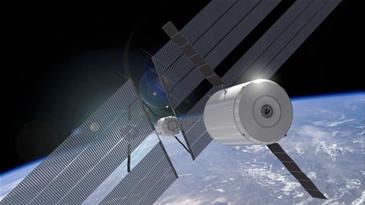NASA’s Blueprint for New Space Technologies
At the American Institute for Aeronautics and Astronautics’ 2010 Space conference currently underway in Anaheim, California, NASA announced the latest revision of its programs to develop new technologies that will transform human spaceflight. NASA first began developing these plans in February following the Obama administration’s unveiling of its new space policy, and revealed them to the space community in May. Already however, significant changes have been made, in small part due to feedback from the space community, but mostly due to Congressional opposition to the White House’s policy. The House and Senate are fashioning a compromise, but NASA’s representatives cautioned that the impasse over the 2011 Financial Year budget is not likely to be resolved until several months into FY2011, and so even more changes are likely in the near future.

by an array of solar panels that can deliver 30 kilowatts.
Courtesy NASA.
However, at least in broad strokes, the agency’s commitment to developing and demonstrating certain technologies it believes are critical to its future are clear, with four test missions slated for launch between 2014 and 2018 by NASA’s new Flagship Technology Demonstration program.
The first mission is a Solar Electric Propulsion test flight, scheduled for 2014–a large solar array fitted to a small unmanned spacecraft will generate 30 kilowatts of power that will be used to drive an electric rocket. The mission will last two years, first visiting a dead satellite in geosynchrous orbit to test new proximity sensors for an automated rendevous and docking system NASA hopes to build, and then the spacecraft will go on to visit a near Earth asteroid, studying it with a small set of science instruments. NASA hopes such a propulsion system will let them build efficient space tugs, or power space debris removal vehicles.
The second mission will launch a satellite that will demonstrate the ability to store cryogenic propellants such as liquid oxygen, and then transfer propellants from one spacecraft to another. The 200-day mission is targeted for 2015 and will demonstrate the technologies needed to build in-space refueling depots. Such depots could make it much easier and cheaper to send manned and unmanned spacecraft beyond low Earth orbit, as the fuel for long journeys won’t have to be brought up all in one go, meaning smaller rockets can be used.
NASA hopes to launch the third mission in 2016; this would be an inflatable habitat module more or less permanently attached to the International Space Station, similar to the modules currently being developed by Bigelow Aerospace for a private space station. In 2018, NASA would use the inflatable module as a test bed for an advanced life support system intended for long-duration manned missions.
The fourth and final mission planned would also launch in 2018, and demonstrate how NASA can use aerocapture and other techniques to land large payloads on Mars. With current technology, NASA can’t land more than 1,000 kilograms on the Martian surface at a time, far too little for a human mission. It hasn’t yet been determined if the flight test would actually take place at Mars, or if useful results could be obtained by testing the technology with Earth’s atmosphere.
Keep Reading
Most Popular
Large language models can do jaw-dropping things. But nobody knows exactly why.
And that's a problem. Figuring it out is one of the biggest scientific puzzles of our time and a crucial step towards controlling more powerful future models.
The problem with plug-in hybrids? Their drivers.
Plug-in hybrids are often sold as a transition to EVs, but new data from Europe shows we’re still underestimating the emissions they produce.
Google DeepMind’s new generative model makes Super Mario–like games from scratch
Genie learns how to control games by watching hours and hours of video. It could help train next-gen robots too.
How scientists traced a mysterious covid case back to six toilets
When wastewater surveillance turns into a hunt for a single infected individual, the ethics get tricky.
Stay connected
Get the latest updates from
MIT Technology Review
Discover special offers, top stories, upcoming events, and more.